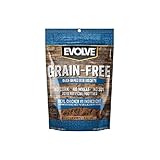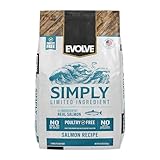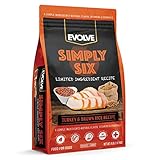If you’ve wandered the pet-food aisle lately, you know the “natural and grain-free” claim is everywhere—yet few brands explain what that actually means for the cat batting at your shoelaces. Evolve has quietly doubled-down on clean-label recipes that mirror a feline’s ancestral prey diet while still meeting 2025 nutritional standards. Before you drop another bag into your cart, let’s pull back the curtain on what makes a truly modern, grain-free formula worth the premium—and how to spot marketing fluff from across the store.
From novel-protein sourcing to postbiotic gut support, today’s best natural foods look nothing like the kibble your childhood cat crunched. Below, you’ll find a field guide to decoding labels, comparing nutrient densities, and tailoring macros to your cat’s life stage—so you can evolve your feeding strategy right alongside your favorite four-digit carnivore.
Top 10 Evolve Cat Food
Detailed Product Reviews
1. Evolve Classic Crafted Meals Chicken Recipe Cat Food (Pack of 15)

Overview: Evolve Classic Crafted Meals Chicken Recipe Cat Food delivers slow-cooked, shredded chicken in convenient 3.5-oz cups. Marketed as a super-premium wet food, it targets health-conscious cat parents who want grain-free meals without fillers.
What Makes It Stand Out: The cup format is travel-friendly and portion-controlled, eliminating messy can openers. Its short ingredient list and “slow-cooked” claim give it a home-kitchen vibe rare in mass-market wet foods.
Value for Money: At $0.32/oz it sits between grocery and boutique brands. Fifteen cups last a solo cat two weeks when used as a topper, making the per-meal cost reasonable for the ingredient quality.
Strengths and Weaknesses: Pros: grain-free, no soy/wheat/corn, highly palatable for picky cats, easy-to-peel cups. Cons: not a complete diet for full-time feeding, protein level moderate at 9 % min, plastic cups generate waste, aroma can be strong in small apartments.
Bottom Line: Ideal as a rotating topper or small-cat entrée. Buy if you want filler-free wet food in grab-and-go packaging; skip if you need a sole-source diet for kittens or active adults.
2. Evolve Classic Deboned Chicken and Brown Rice Recipe Cat Food, 3lb.

Overview: Evolve’s 3-lb bag of Deboned Chicken & Brown Rice is an all-life-stage kibble that leads with real chicken, chicken meal, and turkey meal, promising balanced everyday nutrition for indoor and outdoor cats alike.
What Makes It Stand Out: The slow-baked process supposedly preserves more amino acids than high-temp extrusion, while additions of kelp, blueberry, and cranberry deliver antioxidants usually reserved for pricier brands.
Value for Money: $4.66/lb lands in the mid-premium tier—cheaper than grain-free competitors yet costlier than Purina. A 3-lb bag feeds one average cat almost a month, so the daily cost stays under $0.50.
Strengths and Weaknesses: Pros: first three ingredients are animal proteins, includes taurine & probiotics, made in USA, free from by-product meals, corn, soy, or artificial colors. Cons: contains rice and oatmeal—fine for most cats but not grain-free zealots; kibble size tiny, some cats swallow without chewing; reseal strip occasionally arrives torn.
Bottom Line: A solid everyday kibble for owners wanting quality animal protein without boutique pricing. Choose it if grains aren’t a concern; look elsewhere for strictly grain-free diets.
3. Evolve Grain Free Ocean Whitefish and Egg Cat Food

Overview: Evolve Grain-Free Ocean Whitefish & Egg recipe swaps land poultry for ocean whitefish, catering to cats with chicken allergies or wilder taste preferences. The formula is corn-, wheat-, and soy-free, positioning itself as an ancestral diet in a 2.75-lb bag.
What Makes It Stand Out: Single-source whitefish as the #1 ingredient is rare in this price bracket, and the inclusion of egg protein boosts biological value while adding shine to the coat.
Value for Money: $5.57/lb pushes toward premium territory, but you’re paying for grain-free convenience and allergy management—often cheaper than veterinary novel-protein diets.
Strengths and Weaknesses: Pros: fish-first formula, taurine fortified, USA-made, no cheap fillers, crunchy texture helps reduce tartar. Cons: strong fish smell permeates cupboards, bag isn’t resealable, protein (32 %) may be too rich for sedentary cats, kibble dyed slightly gray—some owners find it off-putting.
Bottom Line: Best for chicken-fatigued or allergy-prone cats that still do well with grains excluded. Accept the ocean aroma and you’ll get a high-protein, coat-conditioning kibble worth the extra cents.
4. Evolve Classic Deboned Chicken and Brown Rice Recipe Cat Food, 15lb

Overview: This 15-lb economy sack is simply the bulk version of Evolve’s Deboned Chicken & Brown Rice recipe, offering identical nutrition in a size suited to multi-cat households or shelters.
What Makes It Stand Out: Buying big drops the price to $3.00/lb—one of the lowest cost-per-pound rates for a diet that still lists three animal proteins ahead of grains and excludes by-product meals.
Value for Money: Exceptional. A two-cat home will empty the bag in about six weeks, translating to roughly $0.20 per cat per day—hard to beat for a USA-made, slow-baked kibble.
Strengths and Weaknesses: Pros: same quality ingredient deck as 3-lb size, money-saving bulk format, sturdy woven bag, integrated tear strip plus handle. Cons: 15 lbs is heavy to lift and store, fats can go rancid if not kept cool, no Velcro seal—plan to clip or bin it, large kibble supply may tempt over-feeding.
Bottom Line: If you like Evolve’s chicken recipe and have the storage, upsizing is a no-brainer. The savings are real, and the formula doesn’t compromise—just monitor freshness and portions.
5. Evolve Pet Food Classic Crafted Meals Chicken Recipe Dog Food, 3.5 Ounce (Pack of 15)

Overview: Evolve ports its popular “Classic Crafted Meals” line to dogs, slow-cooking shredded chicken in 3.5-oz cups designed for toy breeds, seniors, or as a dry-food mixer for any size pooch.
What Makes It Stand Out: Cup packaging means no can openers and zero metal shards; the human-grade appearance of visible chicken shreds appeals to owners who equate visual chunks with quality.
Value for Money: $0.54/oz is steep compared to canned loaf-style dog food, but competitive with similar “in-broth” cups. Used as a 2-tablespoon topper, one cup stretches over two meals, softening the blow.
Strengths and Weaknesses: Pros: grain-free, no artificial colors/soy/corn/wheat, high palability for sick or elderly dogs, portable for travel or daycare. Cons: not formulated as complete nutrition for large puppies, caloric density low—big dogs need multiple cups, plastic waste multiplies quickly, strong chicken scent can linger.
Bottom Line: Perfect for pampering small dogs or enticing finicky eaters. Buy in bulk for a rotational topper, but rely on a balanced kibble for the core diet unless you enjoy buying fifteen cups a week.
6. Evolve Grain Free Deboned Chicken, Sweet Potato and Berry Senior Recipe, 4lb

Overview: Evolve’s Grain-Free Senior Recipe targets aging dogs with a clean, chicken-first formula that skips common irritants like corn, wheat, soy and artificial additives. The 4-lb bag is sized for small breeds or trial periods, yet still packs joint-friendly calories and targeted probiotics.
What Makes It Stand Out: Few “senior” kibbles are both grain-free and built around fresh deboned chicken while still carrying pre-/pro-biotics for gut health. The antioxidant boost from real berries is a nice bonus rarely seen in budget-friendly senior diets.
Value for Money: At just over $5 per pound you’re paying boutique-brand prices for a recipe that reads like foods costing $7-8/lb. For seniors with grain sensitivities, the medical savings from reduced itching or GI upset can repay the premium quickly.
Strengths and Weaknesses:
Pros: Chicken is first ingredient; no cheap fillers; probiotics aid sensitive stomachs; small kibble suits tiny jaws; USA-made.
Cons: Only 4-lb size—multi-dog homes will burn through bags fast; protein (24%) may be low for very active seniors; sweet-potato-heavy recipe isn’t ideal for diabetic dogs.
Bottom Line: If your senior pup is itchy, gassy, or simply picky, this limited-ingredient, gut-friendly formula is worth the slight up-charge. Buy a bag as a tester; most owners never switch back.
7. Evolve Pet Food Grain Free Deboned Chicken, Sweet Potato and Blueberry Dog Biscuits 12-Ounce

Overview: These 12-oz crunchy biscuits act as a grain-free, high-protein snack for dogs of all sizes. Deboned turkey headlines the ingredient list, followed by visible specks of blueberry and sweet potato baked into a satisfying crunch.
What Makes It Stand Out: Most “grain-free” cookies still hide chicken fat or liver; Evolve keeps the recipe turkey-pure and skips every major allergen—corn, wheat, soy, artificial colors, flavors and preservatives—without tasting like cardboard.
Value for Money: $13.41/lb sits mid-pack for premium biscuits. You’re essentially paying $0.42 per 1-oz cookie, cheaper than coffee-shop dog treats and far healthier than colored grocery-aisle bones.
Strengths and Weaknesses:
Pros: Single-source turkey protein; antioxidant-rich blueberries; crunchy texture helps clean teeth; resealable bag stays fresh; suitable for dogs with chicken allergies.
Cons: Pricey for training (you’ll burn through 6-8 biscuits per session); crumbles can stain light carpets; calorie-dense—easy to overfeed.
Bottom Line: Keep a bag on the counter for guilt-free rewarding. One biscuit satisfies longer than a handful of soft chews, making the higher sticker price economical in practice.
8. Evolve Simply Limited Ingredient Salmon Recipe, 14lb.

Overview: Evolve Simply Six Salmon Recipe offers a poultry-free, limited-ingredient diet anchored by deboned salmon and gentle brown-rice fiber. The 14-lb bag suits households seeking a middle ground between grain-free novelty and tummy-friendly grains.
What Makes It Stand Out: Salmon as the first ingredient delivers omega-3s for skin, coat and cognitive support, while brown rice provides soluble fiber without the gluten found in wheat. Being poultry-free opens the bowl to dogs allergic to chicken or turkey—an underserved niche.
Value for Money: $42.99 for 14 lb equals $3.07/lb, undercutting most limited-ingredient salmon diets by 20-30%. USA manufacturing by a family-owned company adds transparency that import brands can’t match.
Strengths and Weaknesses:
Pros: High salmon content (28% protein); no corn/wheat/soy; single animal protein minimizes allergy risk; rice aids digestion; larger bag lowers cost per feeding.
Cons: Strong fish smell straight out of the bag; kibble size may be large for toy breeds; fat level (15%) can soften stool in sedentary dogs.
Bottom Line: For itchy, poultry-sensitive dogs, this is one of the cleanest, most affordable salmon formulas on the market. Transition gradually and your dog’s coat will announce the verdict within a month.
9. Evolve Simply Six Turkey Meal, Brown Rice and Pea Recipe

Overview: Evolve Simply Six Turkey Meal & Brown Rice strips canine nutrition to the essentials: six whole ingredients plus vitamins and minerals. Free from by-product meals, legumes, corn, wheat and soy, it targets owners who want recognizable pantry items in their dog’s bowl.
What Makes It Stand Out: Ultra-short ingredient list meets complete AAFCO nutrition—no exotic proteins, no legume-heavy plant protein boosts, and no gimmicks. Brown rice and whole peas provide steady energy while turkey meal supplies a dense, 27% protein punch.
Value for Money: $4.24/lb lands in the “mid-premium” tier, yet you’re avoiding the $6-7/lb price tag common to limited-ingredient competitors. A 4-lb bag lasts a 40-lb dog roughly two weeks, costing under $0.90/day.
Strengths and Weaknesses:
Pros: Minimalist recipe ideal for elimination diets; turkey meal = more protein per cup than fresh turkey; no legumes lowers gas risk; supports skin & coat with flax; small kibble suits all breeds.
Cons: Not grain-free (rice haters exist); single 4-lb size only; lower fat (13%) may not sustain very active/working dogs.
Bottom Line: When your vet says “simplify,” reach for this bag first. It’s proof that ‘limited ingredient’ doesn’t have to mean ‘limited nutrition’ or ‘unlimited price.’
10. IAMS Proactive Health Indoor Weight Control & Hairball Care Adult Dry Cat Food, Chicken & Turkey Recipe, 7 lb. Bag

Overview: IAMS Proactive Health Indoor Weight & Hairball Care is a purpose-built kibble for adult cats living primarily indoors. The 7-lb bag marries chicken and turkey into a 30% protein, 11% fat formula designed to trim waistlines and minimize hairball surprises on the carpet.
What Makes It Stand Out: A proprietary fiber blend—featuring beet pulp—physically sweeps swallowed hair through the gut instead of letting it wad up. Meanwhile, L-carnitine helps convert fat to energy, addressing the lower activity levels of indoor life without starvation portions.
Value for Money: $2.42/lb is near grocery-store pricing, yet you get targeted functional nutrition typically seen in $3-4/lb “specialty” lines. For multi-cat homes, the 7-lb bag keeps cost per feeding under $0.35/day.
Strengths and Weaknesses:
Pros: Hairball reduction visible in 1-2 weeks; weight control without hunger meows; antioxidants support immune health; crunchy kibble reduces tartar; widely available in stores.
Cons: Contains corn and chicken by-product meal—fine for most, but not for grain-free purists; strong poultry smell; calorie count still demands measured portions.
Bottom Line: If your indoor cat is a hairball factory or getting a bit too “fluffy,” this IAMS recipe offers vet-recommended technology at a budget-friendly price. Measure, feed, and watch the barfs disappear.
## Why “Natural & Grain-Free” Matters for Modern Cats
Cats haven’t changed biologically in 3,000 years, but their food supply has. Learn how ultra-processed fillers crept into the bowl and why removing them can influence everything from coat sheen to litter-box odor.
## The Evolution of Evolve: Brand Philosophy in 2025
Transparency audits, regenerative agriculture partnerships, and carbon-neutral factories—discover how Evolve’s 2025 sustainability roadmap is reshaping what “premium” looks like.
## Key Nutritional Benchmarks for Feline Health
Protein ≥ 40 %, taurine ≥ 0.25 %, omega-6:3 ratio ≤ 5:1—memorize these non-negotiables before you even flip the bag.
## Decoding AAFCO Labels: What “Complete & Balanced” Actually Means
Not all AAFCO statements are equal. We’ll teach you to distinguish feeding-trial proven formulas from nutrient-profiles that were simply calculated on paper.
## Grain-Free vs. Carb-Conscious: Parsing the Fine Print
Grain-free doesn’t always equal low-glycemic. Uncover how peas, potatoes, and tapioca can spike blood sugar just like corn, and how to calculate true carbohydrate content on a dry-matter basis.
## The Role of Novel Proteins in Allergy Management
Duck, rabbit, and even invasive carp are landing in bowls for good reason. Explore the science behind protein rotation and why it’s becoming the first line of defense against food sensitivities.
## Functional Ingredients: From Probiotics to Collagen Peptides
Yeast fermentation products for gut immunity, New Zealand green-lipped mussel for joints, collagen for skin elasticity—separate the research-backed additives from the “pixie-dust” window dressing.
## Wet Food vs. Dry Food: Moisture Metrics That Matter
A 10 % moisture kibble forces a cat to pull 95 % of its daily water from the drinking bowl. See hydration math in action and decide when to mix textures for optimal urinary health.
## Life-Stage Feeding: Kitten, Adult, and Senior Tweaks
Growth diets need 1.4× more calcium, seniors need 20 % less phosphorus—tailor calories, minerals, and fiber to the decade your cat is living in.
## Transitioning Safely: 4-Week Phased Approach
Sudden swaps can trigger gastro chaos. Map out a slow transition that gives the pancreas and microbiome time to recalibrate, plus tips for picky eaters who stage hunger strikes.
## Sustainability & Sourcing: How to Read a Regenerative Label
Look past the bunny logo. We’ll show you which third-party seals (MSC, Regenified, Certified Humane) actually audit soil health, biodiversity, and worker welfare.
## Price-Per-Nutrient Analysis: Getting True Value
A $54 bag with 4 500 kcal/kg and 42 % protein costs less per gram of nutrient than a $39 bag at 28 % protein. Learn the quick division trick that keeps marketing departments up at night.
## Storage & Handling: Keeping Natural Foods Fresh Without Chemical Preservants
Natural tocopherols expire faster than BHA/BHT. Discover oxygen-barrier bags, freezer-stocking hacks, and the ice-cube tray trick for wet food portions.
## Common Red Flags: Label Claims to Avoid in 2025
“Raw-coated” without HPP safety validation, “superfood blend” buried after salt on the ingredient list, and other buzzwords that should send you jogging toward the next shelf.
## Vet Talk: When to Consult a Professional About Diet Changes
From chronic kidney disease to hyperthyroidism, certain conditions override any boutique trend. Know the lab-work markers that signal it’s time to drag the vet into the conversation.
## Frequently Asked Questions
1. Is grain-free automatically better for every cat?
Only if your cat has a verified grain sensitivity; otherwise, focus on total carb load and protein quality.
2. Can kittens eat the same adult grain-free formula?
Not long-term—kittens need higher calcium, phosphorus, and calorie density for proper growth.
3. How do I calculate carbohydrates when the label doesn’t list them?
Subtract protein, fat, moisture, ash, and fiber from 100 % on a dry-matter basis.
4. Will a high-protein diet harm my senior cat’s kidneys?
Research shows no damage in healthy kidneys; monitor bloodwork yearly once your cat hits seven.
5. What’s the ideal omega-6 to omega-3 ratio?
Aim for 5:1 or lower to help curb inflammation and keep skin supple.
6. Are probiotics stable in dry kibble?
Heat-resistant spore-forming strains like Bacillus coagulans survive extrusion; look for CFU guarantees on the bag.
7. How long does an opened bag of natural cat food stay fresh?
Sealed in the original bag inside an airtight bin: six weeks max; after that, oxidation nukes the fats.
8. Can I mix raw food with grain-free kibble?
Yes, but do it at the same meal to avoid GI pH swings, and ensure the raw diet is balanced.
9. Does “human-grade” mean the food is safer?
Only if the facility is USDA-inspected for human food; otherwise, it’s just marketing jargon.
10. Why does my cat drink less on wet food—should I worry?
It’s normal; wet food delivers 70–80 % of daily water needs. Watch for concentrated urine on vet urinalysis instead of counting bowl laps.